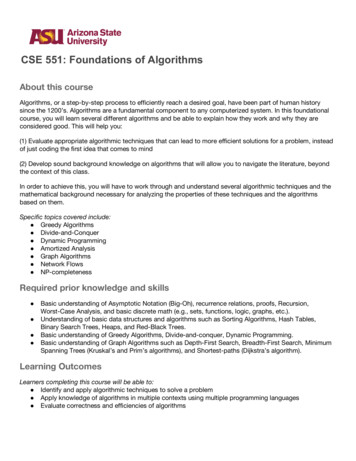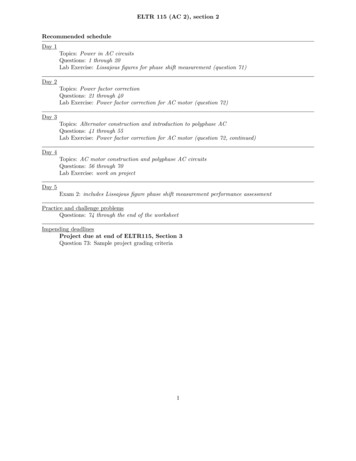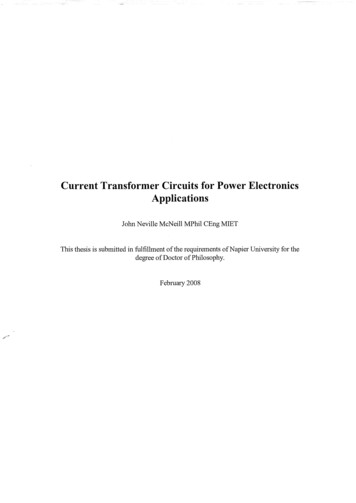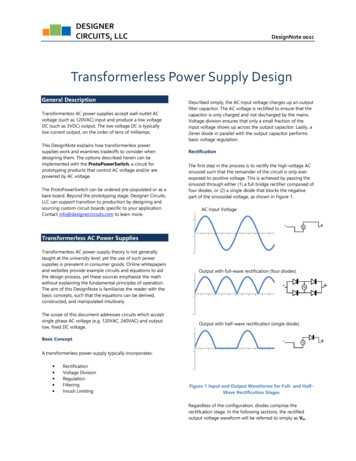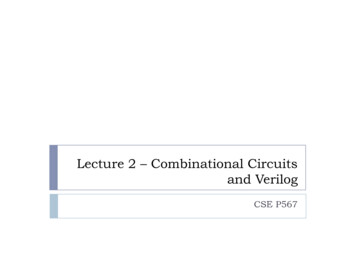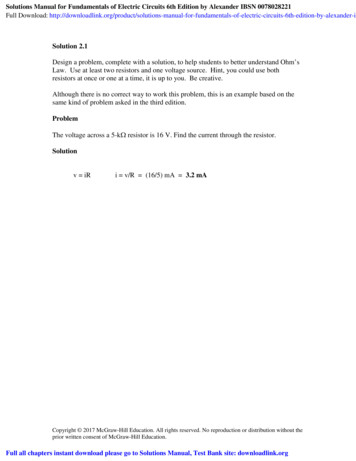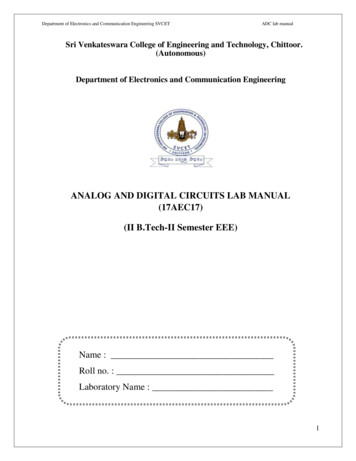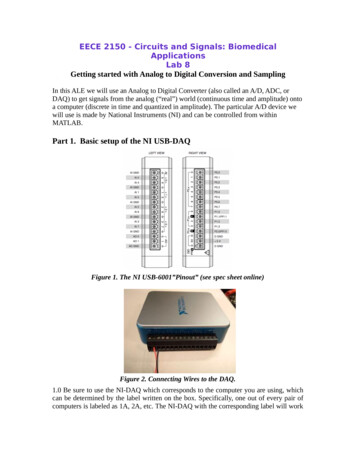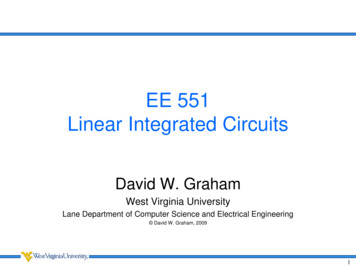
Transcription
EE 551Linear Integrated CircuitsDavid W. GrahamWest Virginia UniversityLane Department of Computer Science and Electrical Engineering David W. Graham, 20091
What You Are Expected To Know Basic circuit analysis– KVL, KCL, voltage dividers, etc.– Basic familiarity with transistors Basic signal processing (helpful, notrequired)– Laplace transforms– Frequency response– Use of MATLAB Basic pn junction device physics (helpful,not required)2
How To Do Well in EE 551 Come to Class––––Pay attentionTake good notesIf I talk about it in class, then it is probably importantDo whatever you have to do to stay awake Do the homework problems–––––Do them againDo them yet again (These problems are typical of analog IC problems)Hide the solutions when you do themWrite out every stepDo not assume that if you can follow the solutions you will be able to dothe problems at test time Start early on the projects– Do the individual parts as they are covered in class– Do not wait until the last minute If you do not understand, then ask questions– In class– In office hours3
Pop Quizzes Extra Credit! At least one per class– Beginning (from last class)– End (from that day’s class) Short – Generally 2-5 minutes We will go over solutions right away3Correct2Close1Attempt (but not close)0No Attempt4
Analyze and DesignVin-Vin Vout5
What Design Really Looks Like6
Why Analog? We have no choice Career stability More efficient (power, processing time, etc.) The best of both worlds Analog AND Digital New advancements new opportunities(Actual Fortune Cookie)7
8
Why Analog Could be Important to You 20% of IC market since 1970“If you’re a 20- to 30-year-oldanalog engineer, you’re sittingpretty right now. It’s a buyer’smarket for you.”- Freescale SemiconductorFrom IEEE Spectrum9
Why This Class Is Important To YouEven if you have no plans of going intoanalog IC design, you will have a hard timenot using analog ICs in your work.Understanding the guts of analog IC designwill enable you to better evaluate theirperformance and choose the right parts.10
Why Analog for Linear Systems?OutsideWorldSensor terface(Analog)OutsideWorldAmplifiers, Filters, Data ConvertersThe real world is analog, so if we need to interface with it,then we must have analog circuitry.11
Why Integrated Circuits? Cheaper (and easier to mass produce)SmallerReduces powerKeeps everything contained– Reduces noise– Reduces coupling from the environment Need a large number of transistors to performreal-world computations/tasks Allows a high density or circuit elements(therefore, VLSI reduces costs)12
Difference Between Discrete and IC DesignAnalog ICsDiscrete AnalogRelatively Smallex. Capacitors 10fF-100pFLargeex. Capacitors 100pF-100μFResistorsMostly badVery expensive (large real estate)Easy to UseCheapInductorsOnly feasible for very high frequenciesExtremely expensiveUse when neededParasiticsVery big concernSeriously alter system performanceExist, but rarely affect performance(Large size of devices and currents)MatchingDifficult to deal withMajor concernStuck with whatever was fabricatedex. 50% mismatch is not uncommonConcernCan more easily match/replaceEfficient(Small currents pA-mA)Use more power(Large currents mA)Device Size andValuesPower13
Process Considerations What processes are – A specific technology for producing integrated circuits– Typically specified by their Type (bipolar, CMOS, or BiCMOS) Minimum device size (length) for CMOS (e.g. 0.5µm, 0.35µm) Various other parameters (e.g. maximum/supply voltage, intendeddisposition – digital or mixed-signal, etc.)– Fabricated by a trusted foundry (e.g. AMI, AMS, TSMC) Everything is geared towards a digital process– Processes not designed with analog in mind– Easiest (best method / most flexible) to design with standardprocess rules– Typically not able to construct many analog circuits in a brandnew process14
Moore’s Law and Its Affect on CMOS Processes Moore’s Law (1965)– The number of transistors on anintegrated circuit doubles every(approximately) 18-24 months Processes vs. time– Introduction of a new processapproximately every two years This shrinks the transistors, so morecan fit in a given space Minimum transistor length decreasesover time Most digital circuits are purely[minimum-sized] transistors– Greatly speeds up processing speeds– Greatly reduces power consumption– Intended to reduce cost, as well (butnew processes can be quiteexpensive)15
Effect of Changing ProcessesWhat changing processes mean (for design) Supply voltages drop (big difference)– e.g. 0.5µm Vdd 3.3V; 0.18µm Vdd 1.8V– New techniques for reduced operating range Device sizes– Transistor sizes decrease with every process– Capacitors may not Short channel effects– Traditional MOSFET models are a poor fit to small devices Varying design rules from process to process (submicronprocesses)– Must relearn “design rules” for each process– Specific rules to make sure nothing breaks16
Process TypeBipolar vs. CMOSPros for Bipolar Work well for analog High gain High speedPros for CMOS Cheap, cheap, cheap! Scales nicely with Moore’s Law Mixed-signal ICs (SOC)17
System-On-A-Chip (SOC)The real reason why CMOS dominates analog ICs – Systems on a chipComplete Integrated CircuitAnalogDigitalEasier, cheaper, and better to do acomplete design on a single chip.Real designs include both analog and digital portions Digital Portion– Scales nicely with Moore’s Law– Straightforward design procedures– Uses mostly small transistors (can really pack them in) and very fewcapacitors Analog Portion––––Scaling mostly comes through ingenuityNo straightforward/automated design proceduresUses often relatively large transistors and capacitorsConsumes a large amount of the chip real estate and design time18
To Summarize Good Things about Analog IC Design Inexpensive Compact Power EfficientNot So Good Things about Analog IC Design(not necessarily bad) Limited to transistors and capacitors (and sometimesresistors if a very good reason) Parasitics and device mismatch are big concerns You are stuck with what you built/fabricated (noswapping parts out)19
Important ConsiderationsWe will limit our discussion to CMOS technologies Only MOSFETs Limited use of BJTsTherefore, we will discuss only silicon processes20
Linear Integrated CircuitsOutsideWorldSensor terface(Analog)OutsideWorldAmplifiers, Filters, Data Converters Circuits and systems are linear only over a specific rangeWe will constantly talk about– Large-signal operation Nonlinear equations DC operating point, bias conditions– Small-signal analysis Linear equations Amplification region Every circuit must be analyzed with both the large- and small-signal analyses21
Large-Signal vs. Small-SignalTypical Amplifier Transfer FunctionVoutGain SlopeVinLinear, high-gain region (amplifier)Nonlinear portions Must first do a large-signal analysis to get the amplifier into range– Bias in the amplification region– DC operating point (DC voltages and currents) from the large-signal operation Once in the amplification region, assume a small-signal input– Everything will stay within the linear region / linear range– Linear, time-invariant (LTI) analysis applies22
Large-Signal vs. Small-SignalTypical Amplifier Transfer FunctionVoutDC Operating PointVin Large signal (Biases / DC conditions)– Moves amplifier into range– Amplifier is now ready to perform amplification Small signal (AC inputs / outputs)– Small sinusoidal inputs makes bigger sinusoidal outputs23
Creating Linear BlocksWhat are the characteristics of the ideal blocks weneed in order to make linear circuits and systems?24
Input / Output RelationshipsDeviceZinZoutReasonIndependent VoltageSource-0Ω0V output no voltage drop; no resistance0V output replace with a short circuitIndependent CurrentSource- Ω0A output no current flows; infinite resistance0A output replace with an open circuitVoltmeter Ω-Minimizes loading effectsNo resistance in parallelAmmeter0Ω-Minimizes loading effectsNo resistance in seriesVoltage-ControlledVoltage Source (VCVS) Ω0ΩVoltage-ControlledCurrent Source (VCCS) Ω ΩCurrent-ControlledVoltage Source (CCVS)0Ω0ΩCurrent-ControlledCurrent Source (CCCS)0Ω Ω25
Input / Output ImpedancesLessons learned Inputs– Voltage sensing Want high input impedance– Current sensing Want low input impedance Outputs– Voltage output Want low output impedance– Current output Want high output impedance26
Input Impedances Inputs– Voltage sensing Desire high input impedance– Current sensing Desire low input impedanceVoltage SensingCurrent SensingNorton EquivalentThevenin EquivalentVsenseINRNRsenseRThV Th -IsenseRsenseVsense I N RN RsenseI sense VTh / (RTh Rsense )Vsense I N RN as Rsense I sense VTh / RTh as Rsense 0Norton and Thevenin equivalents represent the circuit we are sensing27
Output Impedances Outputs– Voltage outputs Desire low output impedance– Current outputs Desire high output impedanceVoltage OutputCurrent OutputThevenin EquivalentNorton EquivalentVoutRThV Th -VoutRinRin VThRin RThVout VTh as RTh 0INRNI out I NIoutRinRNRN RinI out I N as RN Norton and Thevenin equivalents represent the circuit we are sensing.Rin represents the input impedance of the subsequent stage.28
Ideal Operational AmplifierV i 0VoutV-i 0VinVoutIdeal Opamp Model Zero input current– Infinite input impedance Zero output impedance Vout A(V - V-) Gain is infinite If negative feedback, V VExample – Voltage Buffer Infinite input impedance– No loading on previous circuit Zero output impedance– No loading on following circuit Closed-loop gain 1– Looks like a VCVS Completely “buffers” a voltage– Passes V from one circuit to another with noloading effects29
Two-Port Models Most important parameter in an amplifier is gain Must determine how loading affects gain Two-port models simplifies this processi1 v1-i2 v2-Two-PortEquivalenti1i2 One parameter at each port is independent The other port is dependent on both the firstport and the two-port networkAdmittance Parameter Equations Voltage is independent Current is dependent (Typical of most “voltage-mode” circuits)i1 y11v1 y12 v2i2 y21v1 y22 v230
Two-Port Model Admittance Parametersi1 v1i1i1y12 v2y21 y22 v2-Two-PortEquivalenti1y11 v1i2v1i2v2i1i2i2v2 0v1 0v2 0v1 0i2 v1 y12y11v2y21v1-y22 v2-Input admittanceOutput short circuitedReverse transconductanceInput short circuitedForward transconductanceOutput short circuitedi1 y11v1 y12 v2i2 y21v1 y22 v2Output admittanceInput short circuited31
Unilateral Two-Port Model Typically, there is no feedback y12 0 y21 is referred to as “transconductance” (Gm) Convert admittances into impedances– Zin input impedance– Zout output impedanceUnilateral Two-Port Model (Norton Output)i1i2 v1-Unilateral Two-Port Model (Thevenin Output)ZinGmv1i1 Zout v2v1--Zouti2 Zin -a vv1v2-Gainav v2v1 Gm Z outi2 032
Two-Port Model Summaryi1i2 v1ZinGmv1Zout v2-i1Zout v1-i2 -a vv1v2-v2v1voutvin i2 0 Gm Z outiout 0v1 vinZ in i1 iioutinZ out ZinAv v2 i2Gm i2v1v1 0vout iout v2 0ioutvinvin 0vout 0For voltage-in voltage-out circuits,we desire Zin Ω Zout 0Ω33
Connecting a Two-Port Network to a CircuitThevenin SourceRsTwo-Port ModelThevenin Loadi1i2 vin -v1 Rin-av vout v1 vout vin vin v1 vin Rin Gm v1 Rout RL vin Rin Rs v1 Rin ( Gm (Rout RL )) Rin Rs Gmv1Rout v2- voutRL-Assuming Rs and RL are fixed av as Rin av as Rout Therefore, need high output impedancefor high gainav Gm Z out(But want low output impedance foropamps to reduce loading)34
Typical Opamp DesignVin DifferentialGain StageHigh-GainStageVinHigh ZoutOutputStageVout Low Zout Drives large current Only needed for resistive loads If not included, called anoperational transconductanceamplifier (OTA)35
Complete Opamp DesignCompensationVin Vin-DifferentialGain StageHigh-Gain Vout Output Vout'StageStageBiasCircuitryOne size does not fit all.36
The Approach for the Semester Gain appreciation of devices from physicsBuild models of basic devicesCreate small circuitsUse small circuits to build large circuitsFocus on opamp design and supportingcircuitry37
Linear Integrated Circuits Circuits and systems are linear only over a specific range We will constantly talk about – Large-signal operation Nonlinear equations DC operating point, bias conditions – Small-signal analysis

